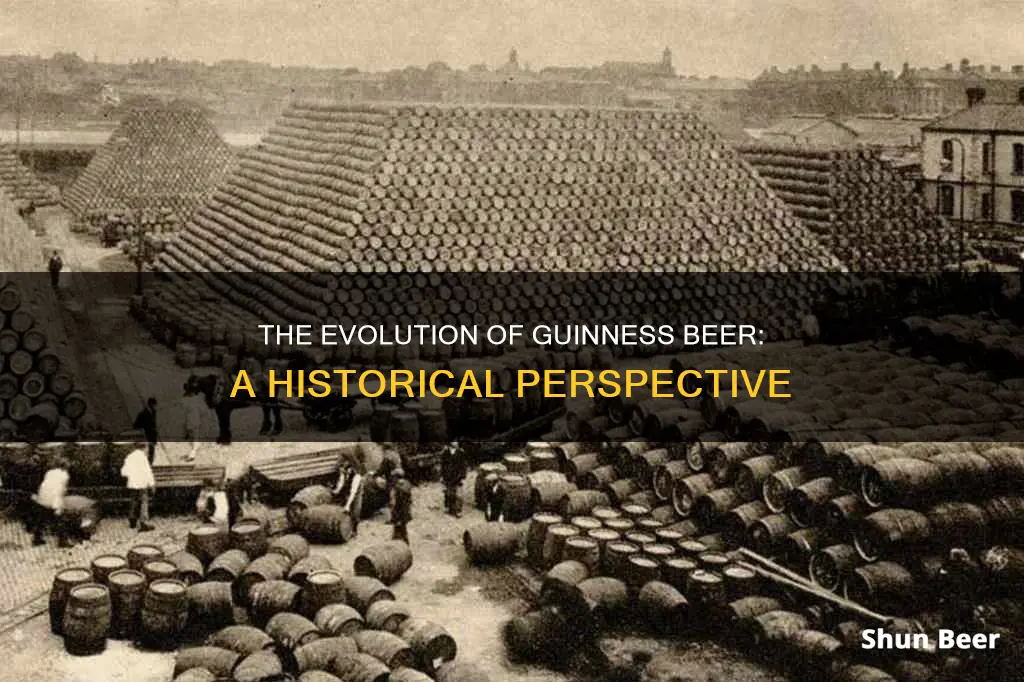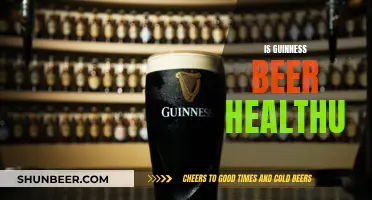
Guinness is a beer that has been brewed at St. James's Gate Brewery in Dublin, Ireland, since 1759 when Arthur Guinness signed a 9,000-year lease on the property. The beer was first exported to England in 1769, and Guinness began brewing porter in the 1770s. By 1799, Guinness had stopped brewing ale altogether in favour of the darker stout. Today, Guinness is one of the most recognisable beer brands in the world and is brewed in almost 50 countries.
What You'll Learn

The history of Guinness beer
Initially, Guinness brewed ale, but soon embraced the new style of beer called porter that was gaining popularity. By 1779, the Guinness Brewery was listed as one of two official suppliers of beer and ale to the seat of government at Dublin Castle. By 1799, Guinness had stopped brewing ales entirely in favour of darker brews.
In 1838, the St. James's Gate Brewery, then run by Arthur's son, Arthur Guinness II, became the largest brewery in Ireland. By 1886, it was the largest brewery in the world, producing 1.2 million barrels annually. Today, it still holds the title of the world's biggest brewer of stout.
Guinness became a public company in 1886 and was valued at £6 million. The Guinness family shareholding decreased over the years, and today, the company is owned by Diageo, a British multinational beverage company formed from the merger of Guinness and Grand Metropolitan in 1997.
Guinness has a rich history of marketing campaigns, from television advertisements to beer mats and posters. One of its most famous slogans was "Guinness is Good for You," which was created in the 1920s and stemmed from market research. Another well-known campaign is the "Brilliant!" series of television advertisements featuring two animated Guinness brewmasters.
Guinness has also been at the forefront of quality control and employee welfare. In 1899, they hired the statistician William Sealy Gosset, who developed techniques such as Student's t-distribution and the Student's t-test. By 1900, the company was operating unparalleled welfare schemes for its 5,000 employees, including higher wages, paid annual holidays, free meals, and a pension scheme.
Guinness has a significant presence in Africa, with about 40% of its total volume brewed and sold on the continent. The first recorded shipment of Guinness to Africa arrived in Sierra Leone in 1827, and the first Guinness brewery outside of Ireland and the UK was established in Nigeria in 1962.
Today, Guinness is one of the most recognisable beer brands globally, brewed in nearly 50 countries and available in over 120. It has a dedicated quality team that ensures only the best-quality pint is poured every time. The Guinness Storehouse in Dublin, a converted brewing facility and museum, is a popular tourist attraction, offering visitors a glimpse into the history and making of this iconic beer.
Guinness Beer: High Iron Content or Just a Myth?
You may want to see also

Guinness's ingredients
Guinness stout is made from a combination of water, barley, roast malt extract, hops, and brewer's yeast. The barley is roasted to give Guinness its distinctive dark colour and flavour. The beer is pasteurised and filtered.
The flavour of Guinness derives from malted barley and roasted unmalted barley. The unmalted barley is a relatively modern addition, only becoming part of the grist in the mid-20th century. For many years, a portion of aged brew was blended with freshly brewed beer to give Guinness a sharp lactic acid flavour. Although Guinness's palate still features a characteristic "tang", the company has refused to confirm whether this type of blending still occurs.
The draught beer's thick, creamy head is created by mixing the beer with nitrogen and carbon dioxide. This was first introduced in 1959, changing the texture and flavour of the beer by making the bubbles smaller than those formed by carbon dioxide alone. The smaller bubbles give the beer a "creamier" and "smoother" consistency.
Guinness Beer: Perfect Pairing Ideas for a Hearty Pint
You may want to see also

Guinness's advertising campaigns
Guinness is a stout that was first brewed in the 18th century, in 1759, by Arthur Guinness at St. James's Gate Brewery in Dublin, Ireland. The company has been known for its advertising campaigns since the 1930s, when it first began to market its product. Here is a look at some of Guinness's most notable advertising campaigns:
"Guinness is Good for You"
This was Guinness's first advertising tagline, introduced in 1794 and used in a campaign during the 1920s. The slogan was created by Dorothy L. Sayers and was based on market research that found people felt good after drinking a pint of Guinness.
"Guinness for Strength"
This campaign, created by S.H. Benson's advertising in the 1930s and 1940s, featured posters with slogans such as "Guinness for Strength", "Lovely Day for a Guinness", "My Goodness My Guinness", and "Guinness Makes You Strong". The posters included distinctive artwork by John Gilroy, often featuring animals such as kangaroos, ostriches, seals, and lions.
"Surfer"
Introduced in 1999, this TV commercial featured a surfer riding a wave while a bikini-clad sunbather took photographs. The advert was inspired by the famous 1980s "Big Wave" Guinness advert, which inspired a line in Christy Moore's song "Delirium Tremens". "Surfer" was named the best television commercial of all time in a 2000 UK poll.
"NoitulovE"
First broadcast in October 2005, this award-winning commercial was set in a bar where drinkers' pints were magically refilled. The advert was designed to be played backwards, with the title being "Evolution" spelt backwards.
"Made of More"
This campaign focused on the Sapeurs, or the Society of Elegant Persons of Congo. It featured stylish Congolese men going about their daily lives before ending the day by dressing up and attending a Sapeurs event, where they danced and enjoyed drinks. The advert promoted the idea that these men were more than they seemed, ending with the quote, "Made of More".
"Black Lager"
A 30-second advert set to the beat of Kanye West's song "BLKKK SKKKN HEAD", this campaign promoted Guinness's lesser-known Black Lager. It featured short clips of Martians, quotes, Guinness branding, and a battle scene, and used the hashtag #MadeOfBlack on social media.
Vegan Alert: Guinness Beer's Surprising Ingredient
You may want to see also

Guinness's worldwide popularity
Guinness is a stout that was first brewed in Dublin, Ireland, in the 18th century. It is now owned by the British-based multinational alcoholic beverage maker Diageo and is one of the most successful alcohol brands worldwide. It is brewed in almost 50 countries and sold in over 120.
The United Kingdom is the largest consumer of Guinness, with one in ten pints sold in London being a Guinness. This is likely due to its proximity to Ireland. Ireland is the second-largest consumer of Guinness, despite the fact that it is the birthplace of the beer.
Nigeria is the third-largest consumer of Guinness, with the beer having been sold there since 1827. Interestingly, it is predominantly sold in glass bottles rather than cans or pint glasses. Guinness Nigeria was founded in 1962 with the construction of a brewery in Lagos.
The United States is another major consumer of Guinness, which can be attributed to the emigration of Irish people to America in the 19th century. Irish pubs are now a staple in most major US cities, and the nation celebrates St Patrick's Day annually.
Cameroon is the fifth-largest consumer of Guinness. However, Diageo has agreed to sell Guinness Cameroon to France's Castel Group.
Guinness Beer: Iron-Rich Brew or Just a Myth?
You may want to see also

Guinness's impact on Ireland
Guinness is a stout that was first brewed in Dublin, Ireland, in the 18th century. It is now owned by the British-based multinational alcoholic beverage maker Diageo and is brewed in almost 50 countries, available in over 120. Despite declining consumption since 2001, Guinness is the best-selling alcoholic drink in Ireland, where Guinness & Co. Brewery makes almost €2 billion worth of beer annually.
Economic Impact
The St. James's Gate Brewery, founded in 1759 in Dublin, Ireland, by Arthur Guinness, became the largest brewery in Ireland in 1838 and the largest in the world by 1886, with an annual output of 1.2 million barrels. Although no longer the largest brewery in the world, it remains the largest brewer of stout. The company has since bought out the originally leased property, and during the 19th and early 20th centuries, the brewery owned most of the buildings in the surrounding area, including many streets of housing for brewery employees and offices associated with the brewery.
In 2015, Diageo launched the Brewers Project, an attempt to diversify the company's product range and expand into the craft beer industry. The company is now one of the most profitable breweries in the world, with Guinness Draught being one of the most successful beer brands worldwide.
Social Impact
The Guinness Storehouse at St. James's Gate Brewery in Dublin is Ireland's most popular tourist attraction, receiving over 20 million visitors since opening in 2000. The storehouse is a converted brewing factory that now serves as a Guinness museum, incorporating elements from the old factory to explain the history of its production.
Guinness has also had a significant impact on Irish culture and society. The brand is closely associated with Ireland, and Guinness is widely considered to taste better in Ireland than anywhere else. An international taste study found that the majority of testers enjoyed pints of Guinness better in Ireland than in any other country. The study claimed to prove scientifically that Guinness does not travel well, as it is more likely to be served fresh in Ireland, where drinking Guinness is a national pastime.
Health Impact
Guinness has also had an impact on health in Ireland, as it was once given to post-op patients in England due to its high iron content. Additionally, a 2003 study found that stouts like Guinness could help reduce harmful cholesterol deposits on artery walls due to their higher levels of antioxidants.
Guinness Beer and Coffee: What's the Connection?
You may want to see also
Frequently asked questions
Guinness beer is over 250 years old. Arthur Guinness founded the St. James's Gate Brewery in Dublin, Ireland, in 1759.
Arthur Guinness founded Guinness beer.
Guinness beer is brewed in almost 50 countries. The flagship location is in Dublin, Ireland.
The main product of the Guinness brewery is Draught Guinness.







